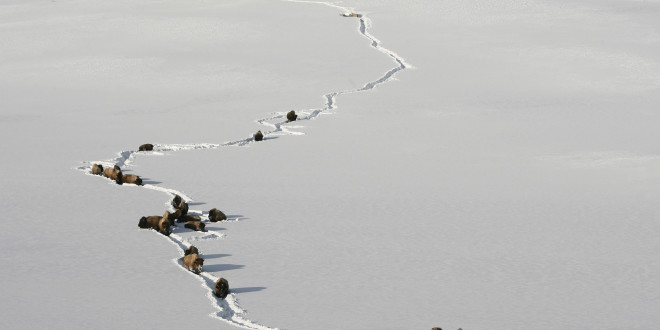The U.S. Forest Service has established two temporary “no shooting” areas near Gardiner to improve safety during the annual bison hunt.
According to the Bozeman Daily Chronicle, the Service signed the orders in December. Under the temporary ruling, shooting is banned on five acres of forestland near the McConnell Fishing Access (east bank) and in Beattie Gulch—both popular areas for hunters.
The move essentially bans hunting in this area, pushing hunters further down a county road from Beattie Gulch. From the Chronicle:
Gardiner District Ranger Mike Thom said the two no shooting areas are meant to protect people who live in the area and to prevent hunters from shooting toward the road or other places where people might be.
“The biggest thing here is that public safety aspect,” Thom said.
Both shooting bans are temporary — the one at the fishing access lasts until next December, the one at Beattie Gulch lasts until May — and Thom said talk of a permanent solution might begin next spring.
Bison hunters from the state of Montana and four Native American tribal reservations hunt Yellowstone bison each year as part of an effort to try to reduce the overall number of Yellowstone bison, of which there are about 5,500. Hunting is done on both the west and north sides of the park, but most of the take happens on the north side, near Gardiner, because more bison migrate out of the park there.
Most of the hunters come from four tribal reservations — the Confederated Tribes of the Umatilla Indian Reservation, the Confederated Salish and Kootenai Tribes, the Shoshone Bannock Tribes and the Nez Perce Tribe. Tribal treaties give them the rights to hunt there. One additional tribe, the Confederated Tribes and Bands of the Yakama Nation, told the state of Montana in a November letter that it intended to start hunting this year, and two others had representatives at a recent bison management meeting that said they planned to start hunting bison in the future.
Tribal hunters can only hunt on public land, so the action is confined to pieces of Forest Service land both bison and people can access. Some of those lands are near homes or the highway, which creates conflicts with the general non-bison hunting public.
The McConnell Fishing Access closure covers about five acres on the east side of the river that is just off the highway and not far from the Gardiner Airport and a subdivision. Thom said some hunters used the area last year, which the agency felt was unsafe.
On the other side of the river lies Beattie Gulch, a Forest Service trailhead that borders Yellowstone National Park. The area, which offers hunters a chance to sit and wait for bison to cross the park line, has become the center of an annual conflict between the people who live there and the hunters. Residents have complained of constant gunfire, hunters in large groups and gut piles left too close to the county road.
In response to complaints from some Gardiner residents, the Montana Environmental Quality Council (by a vote of 9-7) asked Yellowstone to consider letting tribal hunters take bison in Park boundaries. Hunting has been prohibited in Yellowstone’s boundaries since the passage of the 1894 Lacey Act.
McCoy Oatman, vice chairman of the Nez Perce Tribe Executive Committee, told the Chronicle he doesn’t agree with the temporary curb on hunting privileges but agrees that public safety standards should be improved. Oatman acknowledged how concentrating hunting in several small areas “creates kind of a bottleneck there,” but added that members of his tribe and others are “over there to harvest animals.”
This year, the IBMP partner agencies hope to remove at least 900 and upward of 1,300 bison from the Yellowstone herd. After Montana Governor Steve Bullock issued an executive order to allow bison to roam year-round in parts of southern and southwestern Montana, some Yellowstone officials are calling for a change in procedure at the Stephens Creek Bison Capture Facility, where some bison are detained and shipped to slaughter. With the increased presence of bison outside the Park, the Montana Department of Transportation plans to meet with the Buffalo Field Campaign, a local bison advocacy group, to discuss how to protect bison crossing the highway near West Yellowstone.
Ranger Thom, speaking to the Chronicle, said hunters have already been very active around Gardiner. He added that the shooting bans have been “received pretty well” so far.
 Yellowstone Insider Your Complete Guide to America's First National Park
Yellowstone Insider Your Complete Guide to America's First National Park





